|
Size: 21784
Comment:
|
← Revision 138 as of 2015-04-26 19:16:13 ⇥
Size: 6139
Comment:
|
| Deletions are marked like this. | Additions are marked like this. |
| Line 1: | Line 1: |
| ## page was renamed from DieMenschMaschine | [[fungi|{{attachment:8BitFungi.png|Fungi From Yuggoth|align="right"}}]] |
| Line 7: | Line 7: |
| [[attachment:ManMachine.jpg|{{attachment:ManMachineTeaser.jpg|wearable fungi}}]] |
|
| Line 9: | Line 11: |
| = Septambic Chording Keyer = Inspired by Greg Priest-Dorman's [[http://chorder.cs.vassar.edu/|Chorder]] wiki, I'm building a handheld [[https://en.wikipedia.org/wiki/Chorded_keyboard|chorded keyboard]] based on [[http://symlink.dk/projects/spiffchorder/|Spaceman Spiff's Chording Keyboard Experiment (SpiffChorder)]] with some earlier influence from Steve Mann's [[http://wearcam.org/septambic/|septambic keyer]]. Photos and designs published in this section are licensed under the terms of the [[http://www.gnu.org/copyleft/gpl.html|GPL (3.0)]], same as the !SpiffChorder project itself (since they could be considered derivative works). |
= One-Handed Text Input = Have you ever wished you could graft a text input device directly onto your arm? Well, this is about as close as it gets without surgery... Inspired by Greg Priest-Dorman's [[http://chorder.cs.vassar.edu/|Chorder]] wiki, I'm using a handheld [[https://en.wikipedia.org/wiki/Chorded_keyboard|chorded keyboard]] based on [[http://symlink.dk/projects/spiffchorder/|Spaceman Spiff's Chording Keyboard Experiment (SpiffChorder)]] with some earlier influence from Steve Mann's [[http://wearcam.org/septambic/|septambic keyer]]. The subpages linked below provide explicit documentation of my efforts and, in combination with the excellent instructions on Greg's and Spiff's sites, should be more than sufficient for creating one of your own. Photos and designs published in this section are licensed under the terms of the [[http://www.gnu.org/copyleft/gpl.html|GPL (3.0)]], same as the !SpiffChorder project itself (since they could be considered derivative works). |
| Line 12: | Line 14: |
| == Breadboard == | [[/KeyerChords|{{attachment:ChordsTeaser.png|A text-terminal-friendly "modified NASA" chordset reference chart...}}]] [[/KeyerBreadboard|{{attachment:SpiffChorderBreadboardTeaser.jpg|Prototyping a SpiffChorder on a solderless breadboard...}}]] [[/KeyerPerfboard|{{attachment:SpiffChorderPerfboardCircuitTeaser.png|Building a SpiffChorder on perfboard...}}]] [[/KeyerPerfboard|{{attachment:SpiffChorderPerfboardFrontTeaser.png|Building a SpiffChorder on perfboard...}}]] [[/KeyerPCB|{{attachment:SpiffChorderSchematicTeaser.png|Designs for a SpiffChorder printed circuit board...}}]] [[/KeyerPCB|{{attachment:SpiffChorderPaperTestTeaser.jpg|Designs for a SpiffChorder printed circuit board...}}]] [[/KeyerHandset|{{attachment:SpiffChorderHousingInsideTeaser.jpg|Making your own SpiffChorder handset...}}]] [[/KeyerHandset|{{attachment:SpiffChorderHousingAssembledStrapTeaser.jpg|Making your own SpiffChorder handset...}}]] |
| Line 14: | Line 23: |
| [[attachment:SpiffChorderBreadboard.jpg|{{attachment:SpiffChorderBreadboardThumb.jpg|SpiffChorder breadboard}}]] | * [[/KeyerChords|A text-terminal-friendly "modified NASA" chordset reference chart...]] * [[/KeyerProgramming|Installing the SpiffChorder firmware onto an ATmega168 microcontroller from Linux...]] * [[/KeyerBreadboard|Prototyping a SpiffChorder on a solderless breadboard...]] * [[/KeyerPerfboard|Building a SpiffChorder on perfboard...]] * [[/KeyerPCB|Designs for a SpiffChorder printed circuit board...]] * [[/KeyerHandset|Making your own SpiffChorder handset...]] |
| Line 16: | Line 30: |
| I started on a solderless breadboard, shown above, but those really aren't suited for higher-frequency prototyping and so I was getting stray USB device resets at random (particularly if I inadvertently brushed the ground line while not grounding myself first). I used the components in Greg Priest-Dorman's Digikey bill of materials, including the suggested 9x pull-up resistor SIP array (even though I was only testing with 7 keys). I also chose poorly on a preformed bank of 3 yellow LEDs which were somewhat larger than I expected; their rather rigid leads weren't quite a multiple of 0.1" standard breadboard pitch, causing them to crack superficially upon insertion. I used the excellent [[http://www.adafruit.com/products/601|AVR ATmegaXX8 Pinout Stickers]] from [[http://www.adafruit.com/|Adafruit Industries]] to more easily keep track of what I was connecting. | = Head-Mounted Display = This has traditionally been the most expensive and annoying component plaguing wearable computing enthusiasts, and I expect that will continue for some time to come (though I'm trying to stay open-minded about upcoming technologies like Google Glass and Lumus Optical). The optics and display density needed for typical computing on a [[http://en.wikipedia.org/wiki/Head-mounted_display|HMD]] are still not available on the consumer market. Luckily for me, since I spend most of my time using text displays I'm able to get by with a relatively low-resolution solution. At first I wanted a monocular display as a matter of convenience and simplicity, but after reading up on [[http://en.wikipedia.org/wiki/Binocular_rivalry|binocular rivalry]] I'm now starting to suspect there are neurological/cognitive reasons it would be less efficient. |
| Line 18: | Line 33: |
| == Programming == I picked up a [[http://www.adafruit.com/products/46|USBtinyISP AVR Programmer Kit]], [[http://www.adafruit.com/products/174|Barebones AVR dev. board]] and [[http://www.adafruit.com/products/382|28-pin ZIF socket]] from Adafruit on the theory that it would be easier to preprogram the Atmega168 on a dedicated target board. Unfortunately, I followed the !SpiffChorder instructions slightly out of order and burned the external clocking fuse before writing the firmware, thus rendering the unclocked devboard useless... so instead I programmed the microcontroller in-circuit later once the 12MHz crystal and associated components were in place to clock it correctly. I used a machine running [[http://www.debian.org/|Debian GNU/Linux]] and installed their packages for [[http://packages.debian.org/avrdude|avrdude]] and [[http://packages.debian.org/avr-libc|avr-libc]]. You can test the rig after connecting the 6-pin USBtiny cable to ''CON1'' with it set to provide power (and make sure nothing is connected on ''CON2''). {{{ $ sudo avrdude -c usbtiny -p atmega168 avrdude: AVR device initialized and ready to accept instructions Reading | ################################################## | 100% 0.01s avrdude: Device signature = 0x1e9406 avrdude: safemode: Fuses OK avrdude done. Thank you. }}} Assuming it's all working, unpack the latest !SpiffChorder sources (I used 0.99) modify the ''USBaspLoader'' firmware Makefile, program the IC and set its fuses. {{{ $ unzip -q SpiffChorder-0.99.zip $ cd SpiffChorder/USBaspLoader.2008-02-05/firmware $ sed -i 's/^\(PROGRAMMER = -c\) .*/\1 usbtiny/' Makefile $ make avr-gcc -Wall -Os -I. -mmcu=atmega168 -DF_CPU=12000000 -x assembler-with-cpp -c usbdrv/usbdrvasm.S -o usbdrv/usbdrvasm.o avr-gcc -Wall -Os -I. -mmcu=atmega168 -DF_CPU=12000000 -c usbdrv/oddebug.c -o usbdrv/oddebug.o avr-gcc -Wall -Os -I. -mmcu=atmega168 -DF_CPU=12000000 -c main.c -o main.o usbdrv/usbdrv.h:198: warning: ‘usbFunctionDescriptor’ used but never defined avr-gcc -Wall -Os -I. -mmcu=atmega168 -DF_CPU=12000000 -o main.bin usbdrv/usbdrvasm.o usbdrv/oddebug.o main.o -Wl,--section-start=.text=3800 rm -f main.hex main.eep.hex avr-objcopy -j .text -j .data -O ihex main.bin main.hex avr-size main.hex text data bss dec hex filename 0 2134 0 2134 856 main.hex $ cp hexfiles/mega168_12mhz.hex main.hex $ sudo make flash avrdude -c usbtiny -p atmega168 -U flash:w:main.hex:i avrdude: AVR device initialized and ready to accept instructions Reading | ################################################## | 100% 0.01s avrdude: Device signature = 0x1e9406 avrdude: NOTE: FLASH memory has been specified, an erase cycle will be performed To disable this feature, specify the -D option. avrdude: erasing chip avrdude: reading input file "main.hex" avrdude: writing flash (16342 bytes): Writing | ################################################## | 100% 9.58s avrdude: 16342 bytes of flash written avrdude: verifying flash memory against main.hex: avrdude: load data flash data from input file main.hex: avrdude: input file main.hex contains 16342 bytes avrdude: reading on-chip flash data: Reading | ################################################## | 100% 8.56s avrdude: verifying ... avrdude: 16342 bytes of flash verified avrdude: safemode: Fuses OK avrdude done. Thank you. $ sudo make fuse avrdude -c usbtiny -p atmega168 -U hfuse:w:0xd5:m -U lfuse:w:0xff:m -U efuse:w:0x00:m avrdude: AVR device initialized and ready to accept instructions Reading | ################################################## | 100% 0.01s avrdude: Device signature = 0x1e9406 avrdude: reading input file "0xd5" avrdude: writing hfuse (1 bytes): Writing | ################################################## | 100% 0.00s avrdude: 1 bytes of hfuse written avrdude: verifying hfuse memory against 0xd5:avrdude: load data hfuse data from input file 0xd5: avrdude: input file 0xd5 contains 1 bytes avrdude: reading on-chip hfuse data: Reading | ################################################## | 100% 0.00s avrdude: verifying ... avrdude: 1 bytes of hfuse verified avrdude: reading input file "0xff" avrdude: writing lfuse (1 bytes): Writing | ################################################## | 100% 0.00s avrdude: 1 bytes of lfuse written avrdude: verifying lfuse memory against 0xff: avrdude: load data lfuse data from input file 0xff: avrdude: input file 0xff contains 1 bytes avrdude: reading on-chip lfuse data: Reading | ################################################## | 100% 0.00s avrdude: verifying ... avrdude: 1 bytes of lfuse verified avrdude: reading input file "0x00" avrdude: writing efuse (1 bytes): Writing | ################################################## | 100% 0.00s avrdude: 1 bytes of efuse written avrdude: verifying efuse memory against 0x00: avrdude: load data efuse data from input file 0x00: avrdude: input file 0x00 contains 1 bytes avrdude: reading on-chip efuse data: Reading | ################################################## | 100% 0.00s avrdude: verifying ... avrdude: 1 bytes of efuse verified avrdude: safemode: Fuses OK avrdude done. Thank you. $ sudo make lock avrdude -c usbtiny -p atmega168 -U lock:w:0x2f:m avrdude: AVR device initialized and ready to accept instructions Reading | ################################################## | 100% 0.01s avrdude: Device signature = 0x1e9406 avrdude: reading input file "0x2f" avrdude: writing lock (1 bytes): Writing | ################################################## | 100% 0.02s avrdude: 1 bytes of lock written avrdude: verifying lock memory against 0x2f: avrdude: load data lock data from input file 0x2f: avrdude: input file 0x2f contains 1 bytes avrdude: reading on-chip lock data: Reading | ################################################## | 100% 0.00s avrdude: verifying ... avrdude: 1 bytes of lock verified avrdude: safemode: Fuses OK avrdude done. Thank you. }}} Now '''disconnect''' the programmer and '''then''' hold down all three thumb buttons (or short ''N'', ''C'' and ''F'' to ''GND'') while connecting the circuit via USB. If you have the LEDs wired, you should see ''LN'' and ''LF'' light up, indicating it's ready for programming through the virtual USBasp programmer. {{{ $ sudo avrdude -c usbasp -p atmega168 avrdude: warning: cannot set sck period. please check for usbasp firmware update. avrdude: AVR device initialized and ready to accept instructions Reading | ################################################## | 100% 0.01s avrdude: Device signature = 0x1e9406 avrdude: safemode: Fuses OK avrdude done. Thank you. $ cd ../.. $ sudo make program Compiling: main.c avr-gcc -c -mmcu=atmega168 -I. -gdwarf-2 -DF_CPU=12000000UL -Iusbdrv -Os -funsigned-char -funsigned-bitfields -fpack-struct -fshort-enums -Wall -Wstrict-prototypes -Wa,-adhlns=main.lst -std=gnu99 -MD -MP -MF .dep/main.o.d main.c -o main.o -Ikeymaps/ -include nasa_us.h Compiling: usbdrv/usbdrv.c avr-gcc -c -mmcu=atmega168 -I. -gdwarf-2 -DF_CPU=12000000UL -Iusbdrv -Os -funsigned-char -funsigned-bitfields -fpack-struct -fshort-enums -Wall -Wstrict-prototypes -Wa,-adhlns=usbdrv/usbdrv.lst -std=gnu99 -MD -MP -MF .dep/usbdrv.o.d usbdrv/usbdrv.c -o usbdrv/usbdrv.o Compiling: usbdrv/oddebug.c avr-gcc -c -mmcu=atmega168 -I. -gdwarf-2 -DF_CPU=12000000UL -Iusbdrv -Os -funsigned-char -funsigned-bitfields -fpack-struct -fshort-enums -Wall -Wstrict-prototypes -Wa,-adhlns=usbdrv/oddebug.lst -std=gnu99 -MD -MP -MF .dep/oddebug.o.d usbdrv/oddebug.c -o usbdrv/oddebug.o Assembling: usbdrv/usbdrvasm.S avr-gcc -c -mmcu=atmega168 -I. -x assembler-with-cpp -Wa,-adhlns=usbdrv/usbdrvasm.lst,-gstabs -DF_CPU=12000000UL usbdrv/usbdrvasm.S -o usbdrv/usbdrvasm.o Linking: spiffchorder.elf avr-gcc -mmcu=atmega168 -I. -gdwarf-2 -DF_CPU=12000000UL -Iusbdrv -Os -funsigned-char -funsigned-bitfields -fpack-struct -fshort-enums -Wall -Wstrict-prototypes -Wa,-adhlns=usbdrv/usbdrv.o -std=gnu99 -MD -MP -MF .dep/spiffchorder.elf.d usbdrv/usbdrv.o usbdrv/oddebug.o main.o usbdrv/usbdrvasm.o --output spiffchorder.elf -Wl,-Map=spiffchorder.map,--cref -Wl,-u,vfprintf -lprintf_min -Wl,-u,vfscanf -lscanf_min Creating load file for Flash: spiffchorder.hex avr-objcopy -O ihex -R .eeprom spiffchorder.elf spiffchorder.hex Creating load file for EEPROM: spiffchorder.eep avr-objcopy -j .eeprom --set-section-flags=.eeprom="alloc,load" \ --change-section-lma .eeprom=0 -O ihex spiffchorder.elf spiffchorder.eep avr-objcopy: --change-section-lma .eeprom=0x00000000 never used avrdude -p atmega168 -c usbasp -U flash:w:spiffchorder.hex avrdude: warning: cannot set sck period. please check for usbasp firmware update. avrdude: AVR device initialized and ready to accept instructions Reading | ################################################## | 100% 0.01s avrdude: Device signature = 0x1e9406 avrdude: NOTE: FLASH memory has been specified, an erase cycle will be performed To disable this feature, specify the -D option. avrdude: erasing chip avrdude: warning: cannot set sck period. please check for usbasp firmware update. avrdude: reading input file "spiffchorder.hex" avrdude: input file spiffchorder.hex auto detected as Intel Hex avrdude: writing flash (5922 bytes): Writing | ################################################## | 100% 1.33s avrdude: 5922 bytes of flash written avrdude: verifying flash memory against spiffchorder.hex: avrdude: load data flash data from input file spiffchorder.hex: avrdude: input file spiffchorder.hex auto detected as Intel Hex avrdude: input file spiffchorder.hex contains 5922 bytes avrdude: reading on-chip flash data: Reading | ################################################## | 100% 0.95s avrdude: verifying ... avrdude: 5922 bytes of flash verified avrdude: safemode: Fuses OK avrdude done. Thank you. }}} == Chords == Since I spend most of my time in a text terminal, I put together a chord chart which fits safely into a standard 80x24 character screen (I made it 78x22). I also left four empty entries to accommodate custom macros. {{{ +----------+---F-N-CN+ +----------+---F-N-CN+ +----------+------F>CF----+ | -RMI -C- | a A + | | PR-- --- | u U "" | | P--- --F | ret kp ret | | P--I --- | b B \ | | | PR-- -C- | v V ] } | | ---- --F | lshf kp + | | --M- -C- | c C 7 & | | P--- --- | w W 5 % | | PRMI --F | caps kp ins | | --MI --- | d D / ? | | P--I -C- | x X & | | -R-I --F | tab kp - | | -RMI --- | e E = + | | -R-- --- | y Y 4 $ | | --M- --F | bksp kp beg | | P--- -C- | f F 9 ( | | PR-I --- | z Z ` ~ | | -RM- --F | del kp del | | -R-- -C- | g G 8 * | | ---- -C- | spc 1 ! | | P-MI --F | sclk kp / | | -RM- --- | h H 00 | | PR-- N-- | ; : | | P-M- --F | ptsc kp * | | ---I --- | i I 2 @ | | --M- N-- | , < | | -R-- --F | rght kp rght | | -R-I -C- | j J () | | -RM- N-- | . > | | PR-- --F | down kp down | | -R-I --- | k K $ | | -RMI N-- | ' " | | PRM- --F | pgdn kp pgdn | | ---I -C- | l L 6 ^ | | P--- N-- | fnc | | ---I --F | left kp left | | --MI -C- | m M * | | -R-- N-- | esc | | --MI --F | up kp up | | PRM- -C- | n N [ { | | PRM- N-- | lal ral | | -RMI --F | pgup kp pgup | | PRMI -C- | o O 0 ) | | P--I N-- | ins | | PR-I --F | home kp home | | -RM- -C- | p P % | | PR-I N-- | lct rct | | P--I --F | end kp end | | PR-I -C- | q Q ? | | PRMI N-- | nml | | | | | --M- --- | r R 3 # | | PRMI NC- | num | | | | | PRM- --- | s S - _ | | ---- N-F | brk | | | | | PRMI --- | t T 000 | | ---- NCF | rst | | | | +----------+---------+ +----------+---------+ +----------+--------------+ }}} == Perfboard == In an effort not to limit my capabilities with the keyer's software, I wanted to make sure whatever prototype I eventually built could double as a development board. To that end, I implemented all optional components of the !SpiffChorder circuit (programming header, LEDs, pull-up resistors and screw terminals for all 8 chord keys and 3 modifier keys). I tried to keep the layout as compact as possible while still working on single-sided pad-per-hole perfboard, using entirely right-angle traces so as not to make stray contact with corners of square pads. It fits in a 17x21-hole grid including a ground bus all the way around the perimeter. Here's a top-down view showing the logical supply, ground and signal paths colored for easy identification, the front showing just silkscreen markings and jumpers, and one with the traces on the back (mirrored for easier visual reference). [[attachment:SpiffChorderPerfboardCircuit.png|{{attachment:SpiffChorderPerfboardCircuitThumb.png|SpiffChorder perfboard circuit}}]] [[attachment:SpiffChorderPerfboardLayoutFront.png|{{attachment:SpiffChorderPerfboardLayoutFrontThumb.png|SpiffChorder perfboard front}}]] [[attachment:SpiffChorderPerfboardLayoutBack.png|{{attachment:SpiffChorderPerfboardLayoutBackThumb.png|SpiffChorder perfboard back}}]] A revised Digikey bill of materials including all the parts I used: ||<style="background-color: green;">'''index'''||<style="background-color: green;">'''quantity'''||<style="background-color: green;">'''part number'''||<style="background-color: green;">'''description'''||<style="background-color: green;">'''customer reference'''|| ||1||2||490-3709-ND||CAP CER 22PF 50V 5% RADIAL||C1-2|| ||2||2||399-4328-ND||CAP CER 0.1UF 100V 10% RADIAL||C3,5|| ||3||1||493-1767-ND||CAP ALUM 10UF 16V 20% RADIAL||C4|| ||4||1||609-2846-ND||CONN HEADER 6POS DUAL R/A PCB||CON1|| ||5||5||A98335-ND||TERM BLOCK 4POS SIDE ENT 2.54MM||CON2-4|| ||6||1||96018-ND||TOOL SCREWDRIVER SLOTTED 1.8MM||screwdriver for CON2-4|| ||7||2||1N5227BDICT-ND||DIODE ZENER 3.6V 500MW DO-35||D1-2|| ||8||1||ATMEGA168-20PU-ND||IC AVR MCU 16K 20MHZ 28DIP||IC1|| ||9||1||ED90054-ND||IC SOCKET 28PIN MS TIN/TIN .300||socket for IC1|| ||10||1||OD222JE-ND||RESISTOR 2.2K OHM .25W CARB COMP||R1|| ||11||1||OD472JE-ND||RESISTOR 4.7K OHM .25W CARB COMP||R2|| ||12||2||OD820JE-ND||RESISTOR 82 OHM .25W CARB COMP||R3-4|| ||13||3||OD102JE-ND||RESISTOR 1.0K OHM .25W CARB COMP||R5-7|| ||14||1||CSC10KW-ND||RES ARRAY 10K OHM 8 RES 9-SIP||R8-15|| ||15||3||OD103JE-ND||RESISTOR 10K OHM .25W CARB COMP||R16-18|| ||16||1||XC1380-ND||CRYSTAL 12.000 MHZ 18PF CYL||X1|| ||17||7||CH196-ND||SWITCH PUSH SPST-NO 0.01A 12V||key switches|| ||18||1||67-1062-ND||LED 3MM 5V SHORT LENS GREEN DIFF||near thumb lamp|| ||19||1||67-1080-ND||LED 3MM 5V SHORT LENS YEL DIFF||center thumb lamp|| ||20||1||67-1068-ND||LED 3MM 5V SHORT LENS RED DIFF||far thumb lamp|| ||21||1||V2025-ND||BOARD 2-SIDE PPH 2.0X3.0||project board|| I initially sketched the layout on graph paper and transferred it into [[https://live.gnome.org/Dia|Dia]] by hand. [[attachment:spiffchorder.dia|Here's the multi-layer original from which the above graphics were exported.]] Installing all those tiny traces without accidentally shorting any together was painfully time-consuming. This is designed assuming a keyed through-hole 2x3 right-angle shrouded header of the correct size for the USBtinyISP AVR Programmer (CON1), and 5x 0.1" pitch through-hole 4-line right-angle screw terminals (these take a 1.8mm jeweler's screwdriver) to connect leads for all the switches, LEDs and USB (CON2-4). {{attachment:RightAngleShroudedHeader.jpg|right-angle shrouded header}} {{attachment:RightAngleScrewTerminals.jpg|right-angle screw terminals}} [[attachment:SpiffChorderPerfboardFront.jpg|{{attachment:SpiffChorderPerfboardFrontThumb.jpg|SpiffChorder perfboard front}}]] [[attachment:SpiffChorderPerfboardBack.jpg|{{attachment:SpiffChorderPerfboardBackThumb.jpg|SpiffChorder perfboard back}}]] You'll notice this layout uses an 8-resistor array instead of Greg Priest-Dorman's 9x (to save on space). I also show couple of 3-resistor arrays (R5-7, R16-18)... Digikey has no such beast, but I bussed individual resistors mounted vertically by soldering the common leads together above the board (only passing one of the three through the board). == PCB === The printed circuit version is in progress using [[http://fritzing.org/|Fritzing]], and an order has been placed to [[http://fab.fritzing.org/|Fritzing Fab]] for a prototype to QA. I'll post pictures once it arrives in a couple weeks, but here are some tidbits to tantalize: * [[attachment:SpiffChorder.fzz|Fritzing file]] * [[attachment:SpiffChorderEtchable.pdf|combined etchable PDF]] * [[attachment:SpiffChorderGerber.zip|compressed ZIP archive of Gerber files]] == Handset == I hacked up an old telephone handset from my junk pile so I could have something vaguely ergonomic into which to mount the keys. Once I'd separated the front and back of the handset, I opened up tracks for the keys using a small cutting wheel on a Dremmel and also used it to drill a couple holes for a hand strap, then added epoxy in a few places to get the tolerances just right. I sanded the pieces and sprayed them black with a few clear layers of top coat. I ordered 7x [[http://www.wasdkeyboards.com/index.php/row-2-size-1x1-cherry-mx-keycap.html|Row 2, Size 1x1 Cherry MX Keycaps]] from [[http://www.wasdkeyboards.com/|WASD Keyboards]] and popped them onto the stems. I drilled holes near the tops of the three thumb keycaps lining up with the LEDs, and filled each with a dab of clear epoxy. A decorative ribbon was added for the hand strap, and a small block of foam was inserted on top of the circuit board to keep it in place. [[attachment:SpiffChorderHousingPieces.jpg|{{attachment:SpiffChorderHousingPiecesThumb.jpg|SpiffChorder housing, pieces}}]] [[attachment:SpiffChorderHousingInside.jpg|{{attachment:SpiffChorderHousingInsideThumb.jpg|SpiffChorder housing, inside}}]] [[attachment:SpiffChorderHousingAssembledSide.jpg|{{attachment:SpiffChorderHousingAssembledSideThumb.jpg|SpiffChorder housing, assembled, side}}]] [[attachment:SpiffChorderHousingAssembledUnderside.jpg|{{attachment:SpiffChorderHousingAssembledUndersideThumb.jpg|SpiffChorder housing, assembled, underside}}]] [[attachment:SpiffChorderHousingAssembledTop.jpg|{{attachment:SpiffChorderHousingAssembledTopThumb.jpg|SpiffChorder housing, assembled, top}}]] [[attachment:SpiffChorderHousingAssembledStrap.jpg|{{attachment:SpiffChorderHousingAssembledStrapThumb.jpg|SpiffChorder housing, assembled, strap}}]] = Monocular Headmount Display = As I begin work on a wearable display, I'll flesh out this section. Here are some interesting links for components I'm considering: * http://wearcomp.wikia.com/wiki/Myvu_Crystal * http://blog.makezine.com/2009/03/17/myvu-crystal-as-a-wearable-hea/ * http://blog.makezine.com/2009/01/12/myvu-display-in-a-wearable-computer/ |
I've obtained a Vuzix Wrap 920 and Vuzix Wrap VGA Adapter (US$240 combined through Amazon) and removed the cosmetic sunglasses-style lenses to make the rig slightly less obtrusive. This device supports 640x480, 800x600 and 1024x768 resolutions (claimed via EDID on the VGA line) but the native resolution is closer to 640x480 so at first I thought I would stick with that. As it turns out, non-text applications like to make some assumptions about minimum screen geometry (for buttons and the like) which becomes problematic at such low resolutions. Instead, I've set my desktop environment for 1024x768 and increased font sizes where it makes sense to do so. |
| Line 348: | Line 36: |
| Right now I just go everywhere with an [[http://eeepc.asus.com/|Asus Eee PC]] netbook running [[http://www.debian.org/|Debian GNU/Linux]], but intend to transition soon to a low-power single-board computer. Some links for reference: * http://beagleboard.org/ * http://www.raspberrypi.org/ * http://www.cs.vassar.edu/people/priestdo/wearables/top |
At the moment I've got a [[http://beagleboard.org/hardware-xM/|BeagleBoard-xM]] running [[http://wiki.debian.org/ArmHardFloatPort|Debian's armhf port]]. Since the video output is HDMI and there's no inexpensive HDMI-supporting HMD on the market yet (might trade up to a [[http://www.siliconmicrodisplay.com/|ST1080]] eventually), I'm using a High Resolution Video DVI to VGA Converter from !StarTech. I've read that a similar (and cheaper) converter from fit-PC2 will work but it requires [[http://blog.galemin.com/2011/03/dvi-d-to-vga-converter-for-beagleboard-xm/|modifying the BeagleBoard]] (which I'd like to avoid if I can). |
| Line 354: | Line 39: |
| Portable power will also be critical: * http://www.sparkfun.com/products/8290 * http://www.adafruit.com/products/280 * http://www.adafruit.com/products/353 |
The single-board wearable is currently powered from an [[http://www.ianker.com/anker-astro-external-battery-backup-charger/product/79UN5V2-B16P100A|Anker Astro3]], but I may switch it to the lighter and slimmer [[http://www.ianker.com/anker-astro-external-battery-backup-charger/product/79ANS1052-BA|Astro 3E]] once I don't need as many outputs or as much current. I already had a bunch of suitable switching power supplies on hand (Asus ADP-36EH C, replacements are available for very low cost) so I merely fashioned an appropriate adapter cable to fit the input on the Anker. = Motion-Sensing Pointer = I don't really use a mouse much (I can usually get by with the [[http://www.semicomplete.com/projects/keynav/|keynav]] utility wherever pointer interaction is absolutely required), but there are times when having one would be useful. I'll probably build something USB-based with accelerometers, but might instead do something with a small trackball: * http://www.ladyada.net/make/usbgamepad/ * http://www.sparkfun.com/products/9320 |
Man Machine, pseudo human being; Man Machine, super human being.
Kraftwerk, The Man-Machine (1978)
Chronicling fungi's steady descent into cyberpsychosis....
Contents
One-Handed Text Input
Have you ever wished you could graft a text input device directly onto your arm? Well, this is about as close as it gets without surgery... Inspired by Greg Priest-Dorman's Chorder wiki, I'm using a handheld chorded keyboard based on Spaceman Spiff's Chording Keyboard Experiment (SpiffChorder) with some earlier influence from Steve Mann's septambic keyer. The subpages linked below provide explicit documentation of my efforts and, in combination with the excellent instructions on Greg's and Spiff's sites, should be more than sufficient for creating one of your own. Photos and designs published in this section are licensed under the terms of the GPL (3.0), same as the SpiffChorder project itself (since they could be considered derivative works).
A text-terminal-friendly "modified NASA" chordset reference chart...
Installing the SpiffChorder firmware onto an ATmega168 microcontroller from Linux...
Head-Mounted Display
This has traditionally been the most expensive and annoying component plaguing wearable computing enthusiasts, and I expect that will continue for some time to come (though I'm trying to stay open-minded about upcoming technologies like Google Glass and Lumus Optical). The optics and display density needed for typical computing on a HMD are still not available on the consumer market. Luckily for me, since I spend most of my time using text displays I'm able to get by with a relatively low-resolution solution. At first I wanted a monocular display as a matter of convenience and simplicity, but after reading up on binocular rivalry I'm now starting to suspect there are neurological/cognitive reasons it would be less efficient.
I've obtained a Vuzix Wrap 920 and Vuzix Wrap VGA Adapter (US$240 combined through Amazon) and removed the cosmetic sunglasses-style lenses to make the rig slightly less obtrusive. This device supports 640x480, 800x600 and 1024x768 resolutions (claimed via EDID on the VGA line) but the native resolution is closer to 640x480 so at first I thought I would stick with that. As it turns out, non-text applications like to make some assumptions about minimum screen geometry (for buttons and the like) which becomes problematic at such low resolutions. Instead, I've set my desktop environment for 1024x768 and increased font sizes where it makes sense to do so.
Single-Board Wearable Computer
At the moment I've got a BeagleBoard-xM running Debian's armhf port. Since the video output is HDMI and there's no inexpensive HDMI-supporting HMD on the market yet (might trade up to a ST1080 eventually), I'm using a High Resolution Video DVI to VGA Converter from StarTech. I've read that a similar (and cheaper) converter from fit-PC2 will work but it requires modifying the BeagleBoard (which I'd like to avoid if I can).
Portable Power Supply and Charger
The single-board wearable is currently powered from an Anker Astro3, but I may switch it to the lighter and slimmer Astro 3E once I don't need as many outputs or as much current. I already had a bunch of suitable switching power supplies on hand (Asus ADP-36EH C, replacements are available for very low cost) so I merely fashioned an appropriate adapter cable to fit the input on the Anker.
Motion-Sensing Pointer
I don't really use a mouse much (I can usually get by with the keynav utility wherever pointer interaction is absolutely required), but there are times when having one would be useful. I'll probably build something USB-based with accelerometers, but might instead do something with a small trackball:


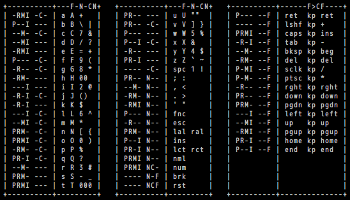
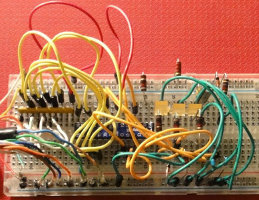
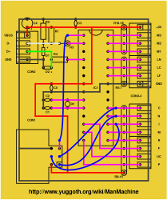
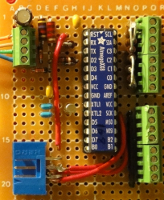
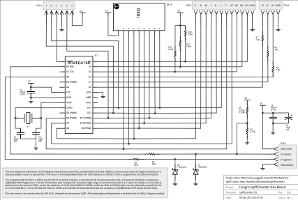
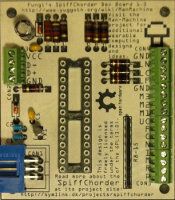
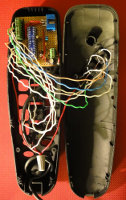
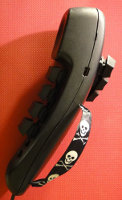
 To the extent possible under law, the creator of this work has waived all copyright and related or neighboring rights to it.
To the extent possible under law, the creator of this work has waived all copyright and related or neighboring rights to it.